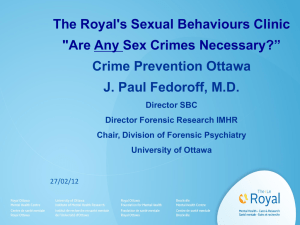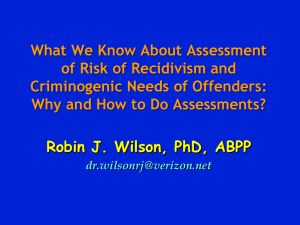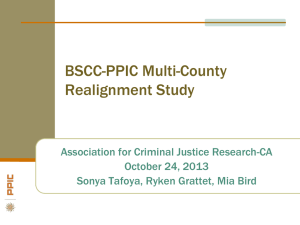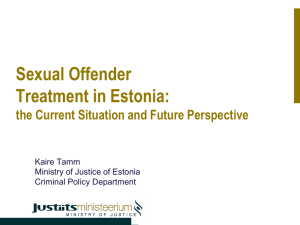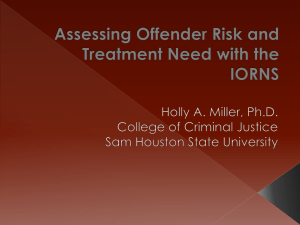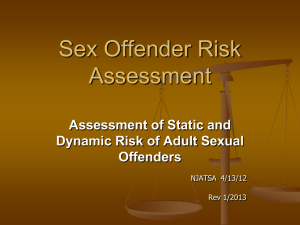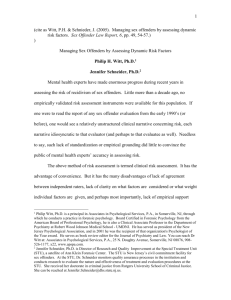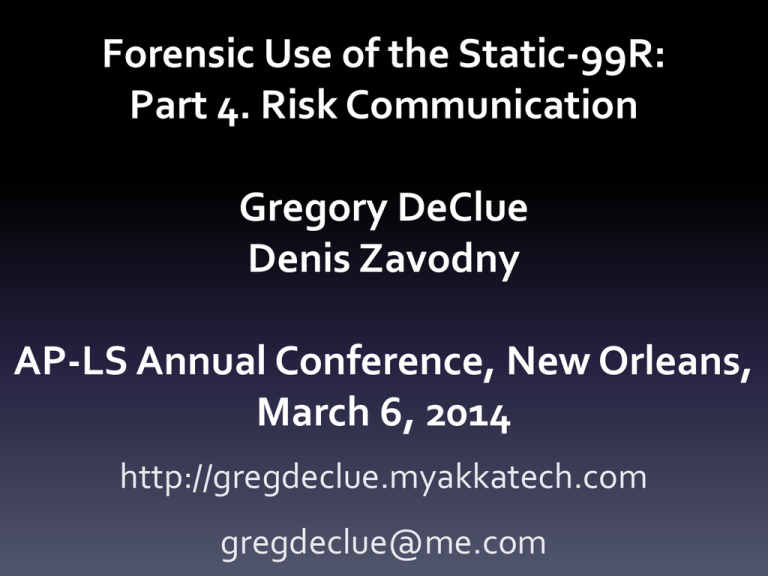
Forensic Use of the Static-99R:
Part 4. Risk Communication
Gregory DeClue
Denis Zavodny
AP-LS Annual Conference, New Orleans,
March 6, 2014
http://gregdeclue.myakkatech.com
gregdeclue@me.com
We consider how evaluators
who use the Static-99R in
forensic cases can
communicate the results in a
way that is meaningful, useful,
and consistent with research.
Six Basic Questions
1. Should I report risk for sexual
recidivism, or risk for detected
sexual recidivism?
2. Should I report individual, or
group, risk?
3. Which group risk should I
report?
4. How can risk be clearly and
accurately conveyed to fact
finders?
5. Do clinical adjustments or
overrides enhance the accuracy
of sexual-recidivism risk
predictions?
6. Is there any objective
procedure that can allow me to
reliably and validly predict that
someone is more-likely-thannot to sexually recidivate if not
confined?
1. Should I report risk for sexual
recidivism, or risk for detected
sexual recidivism?
Specialty Guidelines 11.01 and
11.04 are pertinent.
Evaluators should communicate
risk for detected sexual
recidivism.
2. Should I report individual, or
group, risk?
Specialty Guidelines 10.02,
11.01, and 11.04 are pertinent.
Hart & Cooke, 2013, p. 81:
“ARAIs [actuarial riskassessment instruments]
cannot be used to estimate the
specific probability or absolute
likelihood of future violence
with any reasonable degree of
precision or certainty.”
“Of course, clinicians cannot
use SPJ [structured professional
judgment] guidelines to make
individual risk estimates in the
form of specific probabilities or
absolute likelihood with any
more precision than they can
with ARAIs” (p. 98).
Fazel, Singh, Doll, & Grann
(2012): “Risk assessment tools
in their current form can only be
used to roughly classify
individuals at the group level,
and not to safely determine
criminal prognosis in an
individual case.”
Melton, Petrila, Poythress, and Slobogin
(2007, p. 320): “If the examiner uses
actuarial risk assessment tools, . . . a
precise probability estimate can be
provided. . . . Of course, such estimates, if
presented to the factfinder, should be
carefully explained for what they are:
recidivism rates for people in a particular
population with specific characteristics that
the examinee shares.”
3. Which group risk should I
report?
Specialty Guidelines 2.05, 10.02,
11.01, 11.02, and 11.04 are
pertinent.
We concur with the developers
of the Static-99R that, when
possible, evaluators should use
local norms to interpret the
meaning of a person’s Static99R score.
Generally, when local norms are
not available, evaluators should
use the FULLPOP (Routine)
comparison group, the one
considered to represent the full
range of convicted sex
offenders.
We recommend that evaluators
should not choose a specialized
comparison group on the basis
of clinical considerations unless
and until empirical research
demonstrates that such choices
increase the accuracy of risk
assessments.
4. How can risk be clearly and
accurately conveyed to fact
finders?
Specialty Guidelines 11.01 and
11.04 are pertinent.
We recommend that evaluators
communicate risk by using
concepts from the field of
public health and safety,
expressed in everyday words.
PPV
NPV
NND
NSD
NNT
Number Needed to Treat
Forensic evaluators should not
only be prepared to testify
about risk (dangerousness), but
also about the effectiveness of
sex-offender treatment.
Typically, NNT would be
calculated from the results of
one or more clinical trials.
Dennis, et al. (2012, p. 2),
recently reviewed sex-offender
treatment studies with
randomized trials. They found
no evidence that psychological
treatment reduces sexual
recidivism:
“Without such evidence, the area will fail
to progress. Not only could this result in
the continued use of ineffective (and
potentially harmful) interventions, but it
also means that society is lured into a
false sense of security in the belief that
once the individual has been treated, [his
or her] risk of reoffending is reduced.
Current available evidence does not
support this belief.”
Hanson et al. (2009):
“The sexual and general recidivism rates
for the treated sexual offenders were lower
than the rates observed for the comparison
groups (based on unweighted averages,
10.9% vs. 19.2% for sexual recidivism). . . .
[However,] Reviewers restricting
themselves to the better-quality, published
studies could reasonably conclude that
there is no evidence that treatment
reduces sexual offense recidivism.”
Sexual Recidivism
Hanson et
al. (2009)
Lösel and
Schmucker
(2005)
Hanson et
al. (2002)
Treated
Untreated
NNT
10.9%
19.2%
13
11.1%
17.5%
16
12.3%
16.8%
23
If we restrict ourselves to the betterquality, published research, we could
reasonably conclude that there is no
evidence that treatment reduces sexual
recidivism. If we base the analysis on
encouraging findings from weak
research designs, we would expect to
have to treat about 13 to 23 sex
offenders to prevent one detected sex
crime.
We do not know whether sex-offender
treatment actually works; that is,
whether it actually reduces sexual
reoffending.
If sex-offender treatment does work, we
expect that about 1 in every 13 patients
will benefit from treatment; or, perhaps,
1 in every 23 patients will benefit from
treatment.
In other words, we would expect to have
to treat about 13 to 23 sex offenders to
prevent one detected sex crime.
5. Do clinical adjustments or
overrides enhance the accuracy
of sexual-recidivism risk
predictions?
Generally, no.
Specialty Guidelines 2.05, 11.01,
and 11.04 are pertinent.
6. Is there any objective
procedure that can allow me to
reliably and validly predict that
someone is more-likely-thannot to sexually recidivate if not
confined?
Specialty Guidelines 2.05, 10.02,
11.01, 11.02, and 11.04 are
pertinent.
First, consider data regarding the
Static-99R FULLPOP (Routine)
comparison group, the group
considered to represent the full
population of convicted sex offenders.
There are no levels of the Static-99R
that entail a greater-than-50%
proportion of detected sexual
recidivism. Similarly, there are no PPV
values at or above 50%.
Second, consider that there is, as yet,
no empirical support for choosing a
specialized comparison group at
www.static99.org rather than the
representative group. It follows that
there is no reliable and valid way to
enhance the accuracy of risk
assessment by selecting a higher-risk
comparison group.
Further, there is no empirical evidence
that evaluators who choose a
specialized comparison group produce
more accurate risk assessments than
evaluators who consistently use the
comparison group representative of
the full population of convicted sex
offenders.
Fourth, there has been no empirical
showing that clinical judgment
enhances accuracy of prediction
beyond that of an actuarial riskassessment tool.
Finally, no combination of actuarial
tool(s), SPJ tool(s), and/or clinical
judgment has been identified that
allows evaluators to reliably and
objectively identify a subset of sex
offenders who are more-likely-thannot to sexually recidivate within any
specified time period or within their
lifetimes (Abbott, 2009).
We believe that, whenever an evaluator
anticipates that his or her testimony might
be used to convey that the person is morelikely-than-not to sexually recidivate if he is
not confined, the evaluator has an
affirmative obligation to tell the fact finder
that there is no objective way to predict
that an individual is more-likely-than-not
to sexually recidivate within a specified
time period or within the person’s lifetime.
Primary References
Dennis, J. A., Khan, O., Ferriter, M.,
Huband, N., Powney, M. J., & Duggan, C.
(2012). Psychological interventions for
adults who have sexually offended or are at
risk of offending (Review). The Cochrane
Library, 12. Cochrane Database Syst Rev.
2012 Dec 12;12:CD007507. doi:
10.1002/14651858.CD007507.pub2.
Accessible via
http://www.ncbi.nlm.nih.gov/pubmed/2323
5646
Fazel, S., Singh, J. P., Doll, H., & Grann,
M. (2012). Use of risk assessment
instruments to predict violence and
antisocial behaviour in 73 samples
involving 24,827 people: Systematic
review and meta-analysis. British
Medical Journal, 345, e4692.
DOI:10.1136/bmj.e4692.
Hanson, R. K., Bourgon, G., Helmus, L.,
& Hodgson, S. (2009). The principles of
effective correctional treatment also
apply to sexual offenders: A metaanalysis. Criminal Justice and Behavior,
36, 865-891.
Hanson, R. K., Gordon, A., Harris, A. J.
R., Marques, J. K., Murphy, W.,
Quinsey, V. L., et al. (2002). First report
of the Collaborative Outcome Data
Project on the effectiveness of
psychological treatment of sex
offenders. Sexual Abuse: A Journal of
Research and Treatment, 14, 169-194.
Hart, S. D., & Cooke, D. J. (2013).
Another look at the (im)precision of
individual risk estimates made using
actuarial risk assessment instruments.
Behavioral Sciences and the Law, 31, 81102.
Lösel, F., & Schmucker, M. (2005). The
effectiveness of treatment for sexual
offenders: A comprehensive metaanalysis. Journal of Experimental
Criminology, 1(1), 117- 146.
Melton, G., Petrila, J., Poythress, N. G.,
& Slobogin, C. (2007). Psychological
evaluations for the Courts, Third Edition:
A Handbook for Mental Health
Professionals and Lawyers. New York:
Guilford.

